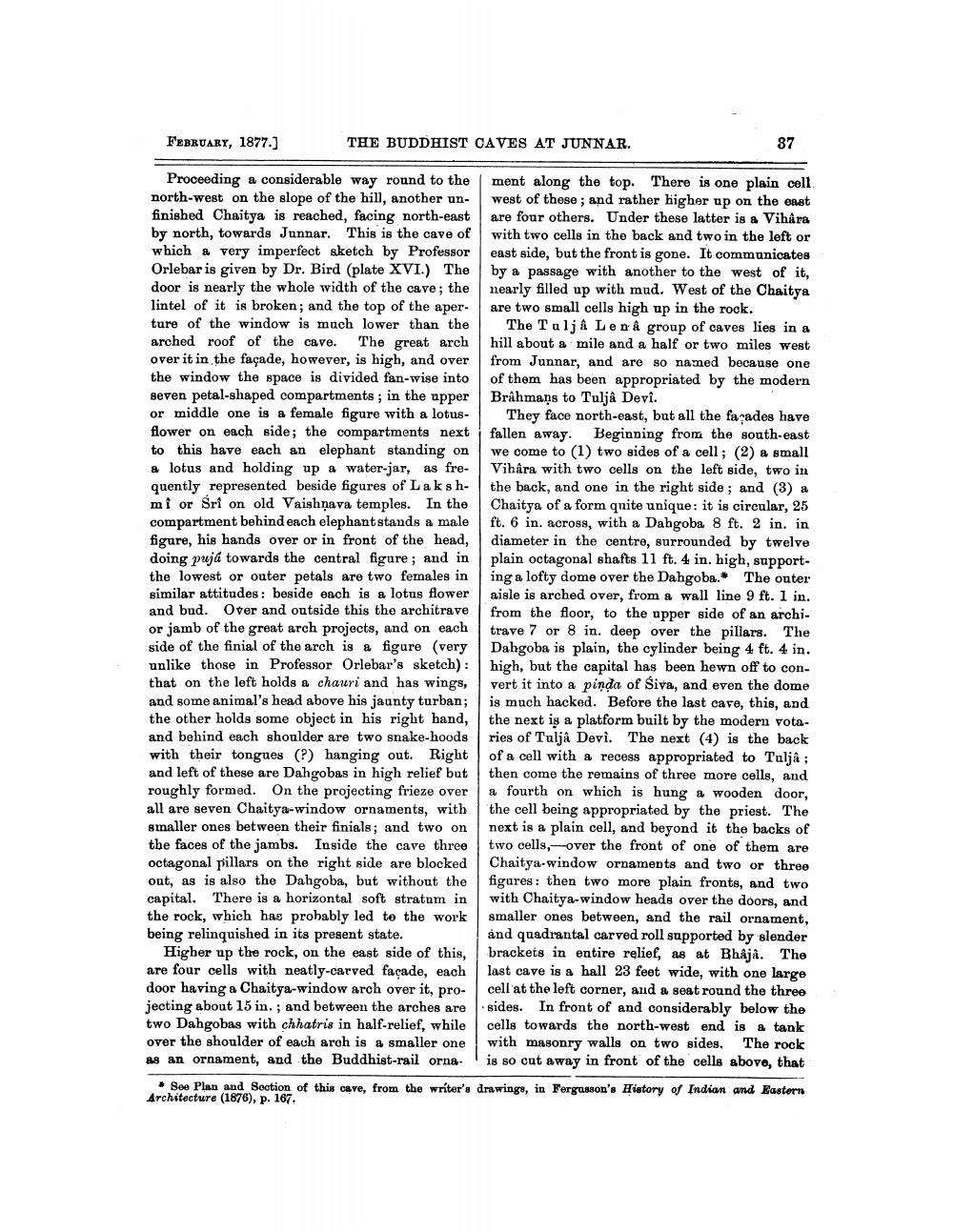________________
FEBRUARY, 1877.]
THE BUDDHIST CAVES AT JUNNAR.
87
Proceeding a considerable way round to the ment along the top. There is one plain cell north-west on the slope of the hill, another un- west of these ; and rather higher up on the east finished Chaitya is reached, facing north-east are four others. Under these latter is a Vihara by north, towards Junnar. This is the cave of with two cells in the back and two in the left or which & very imperfect sketch by Professor east side, but the front is gone. It communicates Orlebar is given by Dr. Bird (plate XVI.) The by a passage with another to the west of it, door is nearly the whole width of the cave; the nearly filled up with mud. West of the Chaitya lintel of it is broken; and the top of the aper are two small cells high up in the rock. ture of the window is much lower than the The Ta ljá Lenâ group of caves lies in a arched roof of the cave. The great arch hill about a mile and a half or two miles west over it in the façade, however, is high, and over from Junnar, and are so named because one the window the space is divided fan-wise into of them has been appropriated by the modern seven petal-shaped compartments; in the upper | Brâhmans to Tuljâ Devi. or middle one is a female figure with a lotus- They face north-east, but all the façades have flower on each side; the compartments next fallen away. Beginning from the south-east to this have each an elephant standing on we come to (1) two sides of a cell; (2) a small a lotus and holding up a water-jar, as fre- Vihara with two cells on the left side, two in quently represented beside figures of Laksh- the back, and one in the right side ; and (3) a mi or Sri on old Vaishnava temples. In the Chaitya of a form qnite unique: it is circular, 25 compartment behind each elephantstands a male ft. 6 in. across, with a Dabgoba 8 ft. 2 in. in figure, his hands over or in front of the head, diameter in the centre, surrounded by twelve doing puja towards the central figure; and in plain octagonal shafts 11 ft. 4 in. high, supportthe lowest or outer petals are two females in ing a lofty dome over the Dahgoba. The outer similar attitudes: beside each is a lotus flower aisle is arched over, from a wall line 9 ft. 1 in. and bud. Over and outside this the architrave from the floor, to the upper side of an archior jamb of the great arch projects, and on each trave 7 or 8 in. deep over the pillars. The side of the finial of the arch is a figure (very Dahgoba is plain, the cylinder being 4 ft. 4 in. unlike those in Professor Orlebar's sketch): high, but the capital has been hewn off to conthat on the left holds a chauri and has wings, vert it into a pinda of Siva, and even the dome and some animal's head above his jaunty turban; is much hacked. Before the last care, this, and the other holds some object in his right hand, the next is a platform built by the modern votaand behind ench shoulder are two snake-hoods ries of Tulja Devi. The next (4) is the back with their tongues (?) hanging out. Right of a cell with a recess appropriated to Talja; and left of these are Dahgobas in high relief but then come the remains of three more cells, and roughly formed. On the projecting frieze over a fourth on which is hung a wooden door, all are seven Chaitya-window ornaments, with the cell being appropriated by the priest. The smaller ones between their finials; and two on | next is a plain cell, and beyond it the backs of the faces of the jambs. Inside the cave three two cells, -over the front of one of them are octagonal pillars on the right side are blocked Chaitya-window ornaments and two or three out, as is also the Dahgoba, but without the figures: then two more plain fronts, and two capital. There is a horizontal soft stratum in with Chaitya-window heads over the doors, and the rock, which has probably led to the work smaller ones between, and the rail ornament, being relinquished in its present state.
and quadrantal carved roll supported by slender Higher up the rock, on the east side of this, brackets in entire relief, as at Bhaja. The are four cells with neatly-carved façade, each last cave is a hall 23 feet wide, with one large door having a Chaitya-window arch over it, pro- cell at the left corner, and a seat round the three jecting about 15 in.; and between the arches are sides. In front of and considerably below the two Dahgobas with chhatris in half-relief, while cells towards the north-west end is a tank over the shoulder of each aroh is a smaller one with masonry walls on two sides. The rock as an ornament, and the Buddhist-rail orna. is so cut away in front of the cells above, that
See Plan and Section of this cave, from the writer's drawingy, in Ferguson's History of Indian and Eastern Architecture (1876), p. 167.




